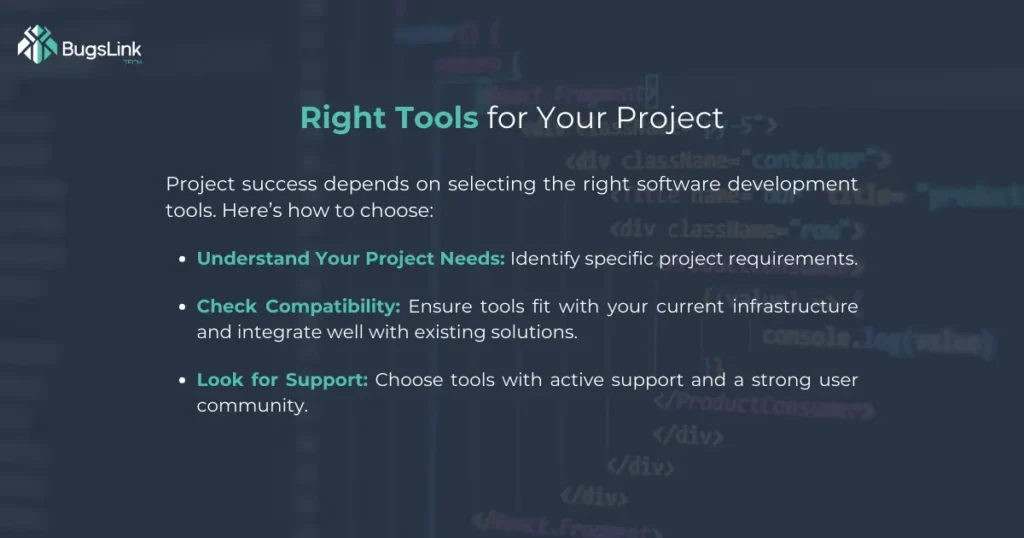Development tools play a crucial role in streamlining the creation of software, ensuring both efficiency and quality. These specialized tools or applications help developers with tasks like coding, testing, debugging, and maintenance.
The tools you select can have a significant impact on the speed, quality, and overall success of your project, whether you’re working on a small application or a large-scale system. In this blog, we’ll take a closer look at the most effective software development tools.
What are Software Development Tools?

Software development tools help automate repetitive tasks, minimize errors, and accelerate the development process. They enhance collaboration, ensure high-quality results, and provide flexibility and scalability. With features for testing and debugging, these tools help catch issues early, making sure the final product meets the required standards.
Before diving into the world of software development tools, it’s important to understand what they are. These tools are programs designed to assist with creating, testing, debugging, and maintaining software. By optimizing the development process, they improve productivity and elevate the quality of your code.
Types of Software Development Tools
Software development tools help designers or developers work constructively, organize code, observe development, and assure the security and quality of their software. A complete list of software development tools is arranged based on their prior uses.
Integrated Development Environments (IDEs)
Integrated Development Environments (IDEs) merge numerous development tools into one application, like Code editors, compilers, debuggers and other tools that improve development speed. IDEs include:
- Visual Studio offers comprehensive debugging and development tools and support for different programming languages.
- Eclipse helps to develop applications in other languages using plugins.
- IntelliJ IDEA is a powerful Java merged development environment (IDE) that delivers brilliant coding support and compatibility with multiple frameworks.
Version Control Systems (VCS)
Version Control Systems (VCS) are indispensable for following original code changes over time. They enable several developers to work together on projects while effectively tracking and combining modifications. Necessary instruments consist of:
- Git is a distributed version control system that lets programmers work independently on branches and merge changes when ready. Famous hosting keys for Git warehouses include GitHub, GitLab, and Bitbucket.
- Subversion (SVN) is a collective, centralized version control system that follows modifications made to a storehouse.
Build Automation Tools
Build Automation Tools are technologies that transform original code into executable programs, execute tests, and design the code for deployment. They facilitate the construction process and aid in dependency management. Typical instruments consist of:
- Maven is a build automation tool for managing project builds, dependencies, and documentation. It is mainly used for Java applications.
- Gradle is a flexible build utility renowned for its scalability and performance. It supports various platforms and programming languages.
- Jenkins is an automation server that automatically facilitates code build, testing, and deployment for developers. It also provides continuous integration and delivery.
Code Editors
Code Editors are more efficient and highly configurable than IDEs despite being more straightforward with syntax highlighting, code completion, and formatting capabilities. They are small, lightweight tools explicitly designed for editing code. As examples, consider the following:
- Visual Studio Code is a Microsoft open-source code editor that is extensible and allows a wide range of languages and frameworks.
- Sublime Text is a robust ecosystem of plugins, making it a swift and adaptable text editor for different programming activities.
- Atom is an open-source editor developed by GitHub that is designed for collaboration and customization.
Continuous Integration (CI) Tools
Continuous Integration (CI) Tools automate software deployment and the experimental integration of code changes, minimizing manual involvement and guaranteeing quicker delivery. Among the notable instruments are:
- CircleCI is a cloud-based CI/CD platform that enables automated testing, deployment, and construction.
- Travis CI is a software project published on GitHub that was developed and tested using this continuous integration service.
- GitLab CI/CD is an integrated component of GitLab that offers project-specific CI/CD pipelines, making it simple to automate the entire software delivery process.
Testing Tools help to test software quality and dependability. Performance and security testing tools and frameworks for unit testing are among them. It consists of:
- JUnit is a Java testing framework that facilitates test-driven development and unit testing.
- Selenium is an open-source program often used for reversal testing to automate web browser testing.
- JMeter is a tool for analyzing system performance by affecting high loads for online applications.
Collaboration and Project Management Tools
Collaboration and Project Management Tools are technologies that let team members collaborate, coordinate tasks, and communicate, keeping projects on schedule. Frequently used instruments include:
- JIRA is a famous Atlassian project management application used in Agile development environments to track problems, bugs, and project improvement.
- Trello is a universal project management application that places tasks and workflows employing cards, lists, and panels.
- Slack is a real-time communication platform that allows teams to work together across diverse development tools.
How to Choose the Right Tools for Your Project

Project success relies on suitable software development tool selection. Here’s how to choose the best choice:
Be aware of your project’s particular requirements before doing anything else.
- Ensure the tools you select are compatible with your present infrastructure and can interface easily with other solutions you already use.
- Active assistance and a robust community can be helpful when dealing with problems. Seek for tools that receive regular upgrades and have a sizable user base.
- Specific tools are free, but others could cost a lot of money. Compare your budget and the features you need to obtain the best value for your project.
Understanding the right software development tools is crucial for creating custom solutions that meet specific business needs. Learn why custom software development is important for success.
Conclusion
Software development tools are an essential part of modern software engineering. They improve teamwork, expedite processes, and guarantee a reliable and expandable result. As technology advances, so will the tools available to developers; thus, staying current on the latest advancements is essential.
FAQs
An IDE provides a more feature-rich environment with automation and debugging tools while developing and modifying code, but a text editor is more portable.
It tracks modifications to the code over time and enables designers to produce previous versions as needed, evading code disputes between developers working on the same project.
Cloud-based tools help developers create, test, and implement apps from any location. They are scalable, flexible, and accessible. These solutions also frequently come with integrated security and performance monitoring.
Automation guarantees consistency in the software development process, especially in CI/CD pipelines, lowers human error rates, expedites repetitive operations, and assures speed.

